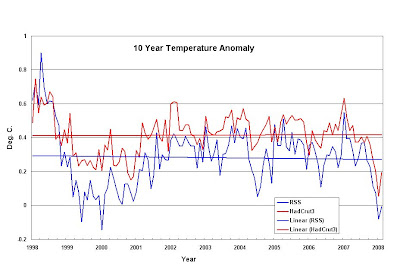
Thursday, December 4, 2008
Wednesday, October 29, 2008
Friday, July 18, 2008
Monday, July 7, 2008
Gavin Schmidt ENSO Adjustment for HadCrut3v Data

Period of chart is from Jan 1998 to May 2008
Divergence between ENSO adjusted data and unadjusted data is .01625 C for 125 months.
Divergence between the Gavin Schmidt method and my own as described below is about 0.029 C for the period.
http://reallyrealclimate.blogspot.com/2008/05/ten-year-hadcrut3-enso-effects.html
The question that must be answered is this - with ENSO accounted for, what happend to the other .18 C of temperature rise that we should be seeing for this time period.
Thursday, June 19, 2008
Monday, June 16, 2008
Three Year Global Sea Level Anomaly

Raw data can be found here:
http://sealevel.colorado.edu/results.php
Monday, May 26, 2008
Wednesday, May 21, 2008
Ten Year HadCrut3 ENSO Effects
Using HadCrut 3 monthly data, I decided to try to isolate the ENSO events of the period under discussion in order to quantify the effect of each event on the slope of the complete chart. Since the complete chart yielded a trend line that was almost dead flat, I decided to use the value y of that trendline as the baseline against which to check the effects of the individual ENSO events.
Beginning with the first La Nina event of 98, I noticed that the La Nina yeilded 4 month of very high residual temperatures, even after the La Nina had ended according to NOAA tables. So I decided to include the four months on the chart, and to also include four months for all the other ENSO events as residual effects time periods. In general, this approach seemed to be very close to capturing the temperature result of each ENSO event.
Since there were only two month between the 98 El Nino and the 98 La Nina, using the four months residual left me with two month that were being used by both the first La Nina and the first El Nino. Since the temperatures for those months were very high, I decided to leave them with the El Nino period and remove them from the La Nina period.
April of 2008 is assumed to be a La Nina month, since the NOAA data is not yet available. But even if it turns out not to be a La Nina month, it would still be used as a residual month.
There were 7 ENSO periods during the decade of the chart. They were:
July98 - June 00 La Nina
May 02 - Mar 03 El Nino
Jul 04 - Feb 05 El Nino
Aug 06 - Jan 07 El Nino
Aug 07 - April 08 La Nina
Details of these periods may be seen in this NOAA chart:
http://www.cpc.ncep.noaa.gov/products/analysis_monitoring/ensostuff/ensoyears.shtml
Complete 10 year HadCrut 3 Temperature Anomoly chart with trend line.
The temperature anomoly effects of the ENSO components are:
El Nino 1 = -0.0744
La Nina 1 & 2 = +0.0992
El Nino 3 & 4 = +0.0372
La Nina 3 = -0.0494
Adding these together we get an ENSO effect of: +0.0126
In summation, all of the ENSO effects for the charted period would actually help the slope of the ten year trend be positive. Depending upon the months that are used, the number could be changed slightly. But in summation, ENSO had nothing to do with the flat temperature trend that we have experienced over the past ten years. The period is not cherry picked for an effect. The .2C per decade rising temperature trend that we should see according to the AGW proponents is not there, and it's abscence remains completely unexplained. The assertion by AGW proponents that the trend was made flat by choosing a period with an El Nino at the beginning and a La Nina at the end is simply untrue.















